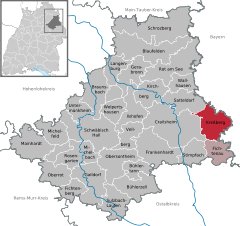Kreßberg
Kreßberg is a community in the district of Schwäbisch Hall in Baden-Württemberg in Germany. No town or village has that name.
Kreßberg | |
|---|---|
 Coat of arms | |
Location of Kreßberg within Schwäbisch Hall district   | |
 Kreßberg  Kreßberg | |
| Coordinates: 49°07′52″N 10°11′03″E | |
| Country | Germany |
| State | Baden-Württemberg |
| Admin. region | Stuttgart |
| District | Schwäbisch Hall |
| Subdivisions | 33 Teilorte |
| Government | |
| • Mayor | Robert Fischer |
| Area | |
| • Total | 48.46 km2 (18.71 sq mi) |
| Elevation | 470 m (1,540 ft) |
| Population (2018-12-31)[1] | |
| • Total | 3,968 |
| • Density | 82/km2 (210/sq mi) |
| Time zone | CET/CEST (UTC+1/+2) |
| Postal codes | 74594 |
| Dialling codes | 07957 |
| Vehicle registration | SHA |
| Website | www.kressberg.de |
The community of Kreßberg consists of 33 separate villages:
Waldtann, Marktlustenau, Mariäkappel, Leukershausen, Bergbronn, Bergertshofen, Wüstenau, Riegelbach, Rötsweiler, Stegenhof, Schwarzenhorb, Hohenberg, Selgenstadt, Vötschenhof, Oberstelzhausen, Unterstelzhausen, Tempelhof, Hohenkreßberg, Gaisbühl, Schönbronn, Bräunersberg, Halden, Vehlenberg, Ruppersbach, Asbach, Haselhof, Waidmannsberg, Mistlau, Neuhaus, Sixenhof, Rudolfsberg, Schönmühle, and Rotmühle
The total population figure of Kreßberg is just 3788 (2010).
First settlements in the Kreßberg area were established between the 7th and the 9th centuries. The community in its current dimensions has existed since 1 January 1973, when the former communities of Waldtann, Marktlustenau, Mariäkappel, and Leukershausen were combined during the municipal reform.
References
- "Bevölkerung nach Nationalität und Geschlecht am 31. Dezember 2018". Statistisches Landesamt Baden-Württemberg (in German). July 2019.